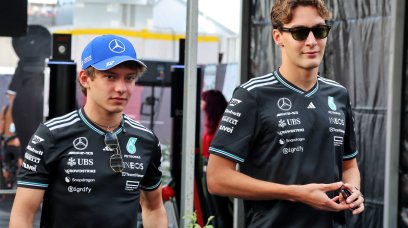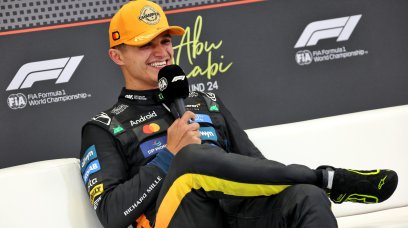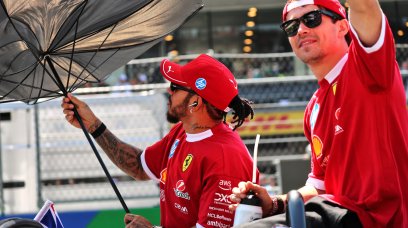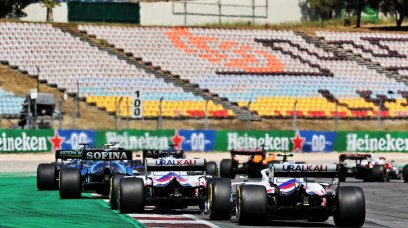Suggestions that Formula 1's 'new era' technical regulations are the sport's last chance of delivering closer racing and thus improved overtaking is probably stretching the point, but it is difficult to see where else the pinnacle of motorsport could venture, given the amount of expertise, effort and resource F1 and the FIA have collectively thrown at framing regulations that deliver what fans pay (very) good money to see: RACING. F1's problem encapsulated in a single word: aerodynamics. The very phenomenon that contributes around 50 per cent of performance via downforce also creates enormous challenges for following cars by reducing the amount of 'clean' air by creating swirling vortices in its wake. In simple terms, the closer following cars get to an overtaking position, the slower they become, with the nature of faster circuits exasperating the problem. When Liberty acquired F1's commercial rights, it realised processions damage the 'show', so allocated funding for dedicated research – a luxury the FIA's resources did not extend to. F1 Managing Director Ross Brawn, the former Ferrari Technical Director who subsequently led his eponymous team to both 2009 titles, tasked a team of top F1 'brains', including Pat Symonds and Jason Somerville, to study the issue. Symonds had previously headed engineering teams during the Michael Schumacher and Fernando Alonso Benetton/Renault championship-winning eras, while Somerville draws on over 30 years' experience as an aerodynamicist with various F1 teams in senior capacities, including Head of Aerodynamics for Williams.
The outcome of F1's research
However, F1's commercial rights agreement between the FIA and F1 - as ratified by the EU in 2000 - calls for a 'hard' division between commercial and regulatory matters. Accordingly, Liberty could, at best, present its research to the FIA, which could accept or reject any findings and recommendations. Now the regulations are fait accompli team has joined the FIA's technical department full-time. Earlier this week, RacingNews365.com attended a presentation jointly hosted by both organisations, at which the respective technical heads outlined the research and studies that presaged the framing of the regulations. Overtaking is all very well, but as in other sports, it is the quality of overtakes or goals or tries or points scored or balls sunk that fans truly crave, not quantity. Thus, stresses Tombazis, the objectives set for the team were not to make overtaking so easy that cars endlessly whiz past each other, but rather to have them race closely enough to exert pressure on the car ahead. "Pat Symonds was involved in doing a lot of the analysis with his team," said Brawn. "The thing you quickly realise is the quality of overtaking is the important thing, not the statistical number of overtakes. "We found we had circuits where there was plenty of overtaking, but it wasn't very exciting because cars were just drafting past each other down the straight, then overtaking under braking or even before they got to the braking zone. That would count as an overtake, but actually wasn't a very interesting overtake."
"The first time such effort has been put in"
They set to work, with the intention being to introduce revised regulations in 2021, but the pandemic threw F1 off-course, forcing a delay of a year. The wider window, though, permitted refinements as and when 'grey areas' arose, so it is fair to state that never before has F1 been as well prepared for a rule change, with the budget cap - introduced on target in 2021 - further levelling the playing field. The two organisations co-operated to frame a set of regulations based on aerodynamic analyses of a 2018-generation car. During the presentation, Somerville claimed they were able to effectively reduce 'following car' downforce loss of five percent at 40m (seven car lengths) to almost nil with the new era designs by reducing the over- and under-car vortices. The effects are even more dramatic the closer the fight: at three car-lengths (20m) a loss of 17 per cent was reduced by a third, and, crucially, when running nose-to-tail from a 43 per cent loss of downforce to 15 per cent. "This is certainly the first time in my [over 40 years] in Formula 1 that such effort has been put into the type of cars we go racing with, both from not just their aerodynamic point of view, but all the points [such as cost control and economic sustainability of teams]," explained Brawn.
Key findings from the investigations
Underbody vortices created by diffusers and the wake of the rear wings were identified as being the main culprits, but these are equally the major performance generators, meaning the team needed to compensate for lost performance by creating downforce by other means, but without leaving a trail of 'dirty' air – achieved by harnessing the so-called 'ground effect', which creates suction beneath the car via 'venturi' tunnels. This solution had first been seen in the eighties, but was banned at the time due to sudden increases in cornering speeds which prevailing technologies and safety standards were unable to cope with at short notice, but ground effects have now been phased in on a tightly controlled basis. Another crucial area is the 'dirty' air created by wheels - particularly at each front corner - which teams channel over and under their cars via vanes and barge boards. "We have to some degree tied their hands behind their back in that we've restricted certain areas," said Somerville. "And we've given them freedom [around] the floor but we've taken away a lot of the freedom they might have had around the front corner because we know that's an area where, given free rein, they'll go down a route which isn't conducive to our research."
Fans might see "more differentiation" than expected
Tuesday’s presentation coincided, of course, with team launches - we jumped off the Liberty call and straight into the Williams unveiling - so the obvious question: has the combined F1/FIA team seen anything on the various cars (or renders) that set alarms bells ringing? "We are undergoing a process with the teams, doing individual sessions with them to track the legalities so we can try to avoid any nasty surprises in the first race," said Nicolas Tombazis, the FIA's head of single-seater technology and seasoned F1 design engineer. "We have seen a few surprises here and there, some areas where cars are a bit more different between them then what we expected and where engineers have applied their innovative skills to come up with a solution," he added. Tombazis then provided some welcome news for fans: "I think you'll see a lot more differentiation than maybe you were expecting to, but I wouldn't say there's been any massive alarm bells so far."
Will there be 'look-alikes' on the 2022 grid?
All well and good, but how long before we see a series of look-alikes on the grid? After all, given the heavily prescriptive regulations, budget caps that reduce leeway for experimentation and heavy resource restrictions, the quickest route to performance is to simply copy what leading teams are doing. "The current new cars will have more visible differentiation, in terms of shape, at least initially," believes Tomazis. "Clearly, engineers will be evaluating solutions of other cars and try to understand why cars are a bit different in one or another way. "I think the regulations are written in such way that the convergence will be faster; so, yes, I expect some differentiation will reduce with time, but I don't think we’ll get to the point of complete look-alikes." Brawn, though, believes that the cost cap will minimise copy-cat antics. "There were predictions that all the cars would look the same when the regulations were first released," he said. "Now they look quite different. "I think there is an extra dimension to 2022, particularly going forward, and that's the cost cap: the ability to completely redesign your car or completely change it is going to be limited by financial resources as well as technical resource." He has a point when it comes to complete redesigns during a season - as occurred with the double-decker diffuser Brawn GP pioneered to such good effect in 2009 and was soon widely copied - but winning innovations are likely to be copied by other teams for their next designs. Visual and technical convergence is, it seems, inevitable; it is merely a question of how long it takes and whether the regulations stamp it out.
What will the outcome be at testing?
Are there, though, likely to be any extreme or unconventional solutions such as the oft-cited 3-D on the Brawn car? "It's not been the intent to allow that, but when the double diffuser sprung on the scene I don't think there had been any intent to allow that," smiles the man whose name was on the nose of that 2009 car. "It was the interpretation of the regulation which proved to be robust enough to stand the protest of the other teams. "You do your very best in developing these regulations - and we've [now] had the benefit of an extra year - but the nature of teams is once they see an opportunity, they rarely alert the FIA or anyone to what they see as an opportunity. "So, you don't get to find out about it until you get to the first race. We've still got a little bit of time before we can say for sure we've seen nothing dramatic, but I think these rules are the lessons that have been learned from the past. "And I think these rules are quite prescriptive in certain areas, so there is certainly less potential and less scope [for extreme], but [we] still have enough scope for engineers to be able to design better racing cars." The acid test will, though, be testing, which commences next week in Barcelona – a circuit where overtaking is notoriously difficult, as evidenced by a simple statistic: the winner at the Circuit de Catalunya started from pole position 22 times in 30 races (73 per cent) versus a historic global incidence of around 40 per cent. Positive comments from drivers about overtaking (or close running) will bode well for the regulations. If not…
Most read









